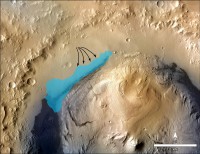The hole that NASA’s Curiosity Mars rover drilled into target rock “John Klein” provided a view into the interior of the rock, as well as obtaining a sample of powdered material from the rock. (NASA/JPL-Caltech/MSSS)
Home The hole that NASA’s Curiosity Mars rover drilled into target rock “John Klein” provided a view into the interior of the rock, as well as obtaining a sample of powdered material from the rock. (NASA/JPL-Caltech/MSSS) The hole that NASA's Curiosity Mars rover drilled into target rock "John Klein" provided a view into the interior of the rock, as well as obtaining a sample of powdered material from the rock. (NASA/JPL-Caltech/MSSS)




